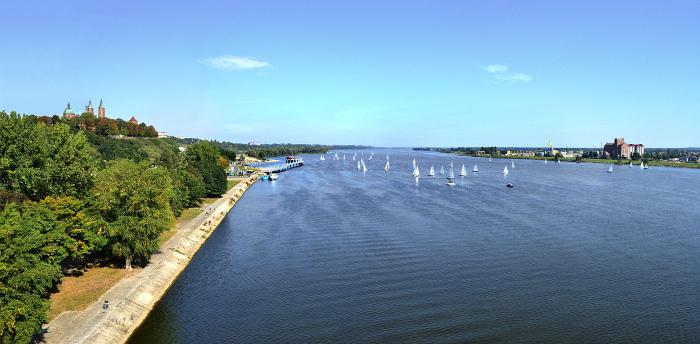Wisla is the river with the greatest length not only in Poland, but also in the Baltic Sea basin. By water, it is second only to the Neva. The origins of the Vistula are located at Baranja Mountain at an altitude of more than 1 thousand meters above sea level in the Western Carpathians (Moravian-Silesian Beskids). Its main sources are Black Hangman and White Hangman. The total length of the river is 1047 kilometers, and its basin area is 198.5 thousand square kilometers. Wisla flows into the Baltic Sea near the city of Gdansk. The depth of the Vistula in some places reaches 7 meters. The most important tributaries of the river are San, Western Bug, Narew and Pilitsa. The maximum width of the channel is 1 thousand meters. The main water supply Vistula receives from tributaries flowing from the Carpathians. The flood of the river depends on melt water. There are floods in both winter and summer. High and rapid rises in water, as well as ice congestion, can lead to flooding. Wisla on the map of Europe is in the middle.

Formation of the Vistula River
On the planet Earth in the Quaternary geological period, the Vistula River appeared. The map of today does not convey either the size or direction of the flow of that waterway. Since then, glaciation has occurred 8 times on the territory of Poland, and each time it has shifted the river valley. Wisla took its current parameters about 14 thousand years ago, when the last Scandinavian ice left the mainland. But even today, the river continues to form, this is evidenced by the accumulation of rainfall over the entire length of the channel and significant erosion of the coasts. The main peculiarity of the Vistula among European rivers is asymmetry. This is a consequence of the "work" of glaciers. Only 27% fall on the left side of the basin, while 73% fall on the right. Along the Vistula there are 3 types of terrain: the Carpathian highlands, the West European Upland and the East European Plain.
History of the river and surrounding areas
For the first time, the Vistula River is mentioned in the historical annals of Pliny the Elder. In the II century AD, the scientist of Ancient Greece Ptolemy wrote that it is the natural border of the territories between the lands of the Sarmatians and Germans. In ancient Rome, the Vistula River basin was considered the land of Germanic tribes. The settlement of these territories by the Slavs took place in the VI-VIII centuries. The Wistlians created a state with three capitals: Krakow, Straduv and Sandomierz. In the X century, the country was conquered by another tribe of Slavs - glades, which created modern Poland. Krakow remained the capital. Polish kings were crowned here until 1610, when Warsaw became the center of the state. The Vistula has always remained the most important waterway from the inland territories of Europe to the Baltic Sea.
The economic importance of the Vistula
Wisla (Poland) - the largest waterway in the country. It contains up to 60% of all water reserves, and its basin covers half of the state. In the Polish economy, the Wisla River plays a significant role. It has developed freight and passenger shipping for ships with a displacement of up to 500 tons. There are several hydroelectric power stations on the Vistula River, the largest of which is Wloclawek Hydroelectric Power Station. Its capacity is more than 160 MW. In addition to the water supply to Poland’s housing stock, the river provides water to industrial enterprises, such as the Novaya Guta metallurgical plant and the metallurgy giant Kotovice, petrochemical enterprises in Plock, FAS workshops (Warsaw Passenger Car Plant), nitrogen fertilizer plants in Wloclawik and many others.
Attractions, recreation and tourism
Wisla is a river attractive for a varied holiday. These are hiking and water tourism, as well as river cruises. There are two wonderful landscape parks on it: at the mouth and Vepsh. The river flows through such large Polish cities as Warsaw, Krakow, Gdansk, Wloclawek, Plock, Tarnobrzeg, Torun and others. The peninsula in the Gulf of Gulf of Westerplatte is interesting, where the first battles of the Second World War took place. Traveling around the Vistula, you can see amazing monuments of architecture and history: the Cathedral of Saints Stanislaus and Wenceslas in Krakow, the Old Town in Tarnobrzeg, the Royal Castle, Lazenski and the presidential palaces in Warsaw, the Solidarity Bridge in Plock, the town hall and the royal chapel in Gdansk, the house the famous astronomer Nikolai Copernicus in Torun, the Czartoryski Palace and Park Ensemble in Pulaw. Tourist routes in the Vistula in recent years have been very popular among Russians.